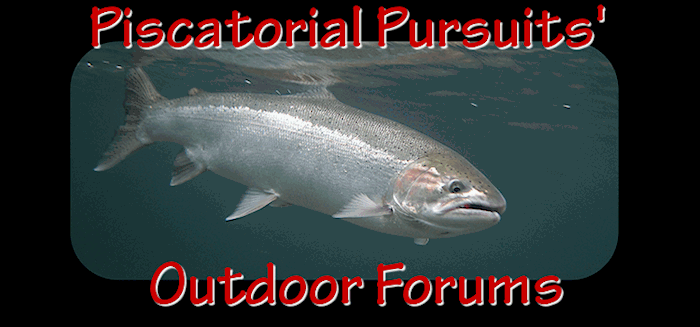Wow! What a thread! Facts, opinions, ethics, and morals - a mixture that has no correct conclusion. If you want to get in a debate that cannot be won, debate religion. Many of the steelheaders I know treat their personal fervor for steelhead with all the reverence of a religion, especially if the subject is about wild steelhead.
Fundamentally, there is nothing inherently good or bad about killing a wild steelhead. Once killed, it won't reproduce. That may make a difference to the population in the subsequent generation, or it may not. Just as killing a particular wild chinook, coho, deer, or elk may, or may not, affect population abundance in the next generation. Oh, but there are some differences. Differences that can be explained by certainty - or the lack thereof.
Game managers usually have a fair idea of the size of deer and elk herds, so they don't have to "guess" about things like ocean survival before setting seasons, the the big game harvests are somewhat (I said somewhat!) easier to control. Managing a migratory fish population like wild salmon or steelhead is a lot more difficult. For most rivers, the manager has to start with a scientific estimate (guess) about how many smolts migrated to the ocean, then estimate (guess) the smolt to adult ocean survival, then set the harvestable number, assuming there are any over and above the spawning escapement goal (assuming there is a spawning escapement goal), then regulate the fishery in the ocean, Puget Sound, lower Columbia River, Grays Harbor, etc., and every bay and river mouth and recreational fishing section of every river, so that precisely the correct number of fish of each species is caught in the right fishery (treaty and non-treaty), and still have the proper number arrive at the spawning grounds to satisfy the losses due to floods, excessive sedimentation, poachers, and have enough fry emerge from the gravel the following spring or summer to fully seed all the available juvenile rearing habitat to keep the river at its maximum productivity. Heck, Microsoft couldn't write an algorythm that would actually accomplish that. Oh, mark me, many fisheries managers have written such formulas and programs clogging up tons of computer space, but they all fail. They fail because they cannot account for variability and the lack of certainty in natural ecosystems to predict the harvestable number of fish with any consistent reliability. But so strong is our faith in math and models, and so strong is our desire - or rather our collective demand - to harvest as many fish as we possibly can, we choose to tolerate consistently poor performance in the area of harvest management, rather than err on the side of caution. Caution that would nudge us to harvest fewer and send more fish to the spawning grounds from most runs.
I used to favor allowing the harvest of wild steelhead over and above spawning escapement requirements. I did so in part because I was choosing to ignore that aspect of human nature that propels us to push every system we control - or believe we control - to its absolute limit. As a consequence, we have overharvested just about every fishery of consequence in the world. Worth repeating - every fishery of consequence in the world.
For that reason alone, I'm willing to support wild steelhead release, and waste those surplus spawners on the various spawning grounds, wherever and whenever they may occur, scattered in a very few rivers worldwide, even though they probably won't contribute directly to an increase in the population of the next generation of steelhead. The amount of waste that will occur is trivial, and in an ecological sense, not wasteful at all. The ecosystem will absorb all that is there, just as it did for thousands of years before we improved on things with modern fisheries management.
A few other random points:
Yes, it was the Kalama River studies that indicated steelhead spawning by hatchery X hatchery and hatchery X wild crosses produced almost no adults in the subsequent generation. The hatchery winter runs perform most poorly, probably because they are so out of synchrony regarding spawn timing. Summer runs only did slightly better, even though hatchery summer run spawn timing is fairly close to wild spawn timing. I don't know if there is any other plausible explanation.
Hatchery coho do spawn quite successfully in the wild. Reasons include: the hatchery fish are often from their native river. More important, probably, is that the hatchery coho spawn at about the same time as the wild coho.
Another point to consider in trying to effectively manage the harvest of wild steelhead: most would agree that even in the best of circumstances, the number of harvestable wild steelhead in any one population would be relatively small, compared to say, salmon populations. Not always, but usually. At the same time, the population of steelhead anglers grows larger. It kind of reminds me of some recent commercial fisheries, where the open season - which used to be measured in weeks - was not specified in days even, but rather it was open for a certain number of hours. Imagine a wild steelhead kill fishery open on your favorite river for 4 hours! And since good management dictates that harvest occur throughout the timing of the run, we have just committed bad management if the run could only withstand a 4 hour season, and we didn't spread it throughout the many months that the run actually occurs over.
Like I said, the "waste" from the loss of a wild steelhead harvest fishery is trivial. I've more important things to be concerned about, but that's just me.
But ain't it a gas seeing those upper Cowlitz steelhead and coho numbers climbing up and up like that? And when smolt collection gets really good, ain't we gonna' be some happy campers then?
Sincerely,
Salmo g.













 Previous Topic
Previous Topic Index
Index


